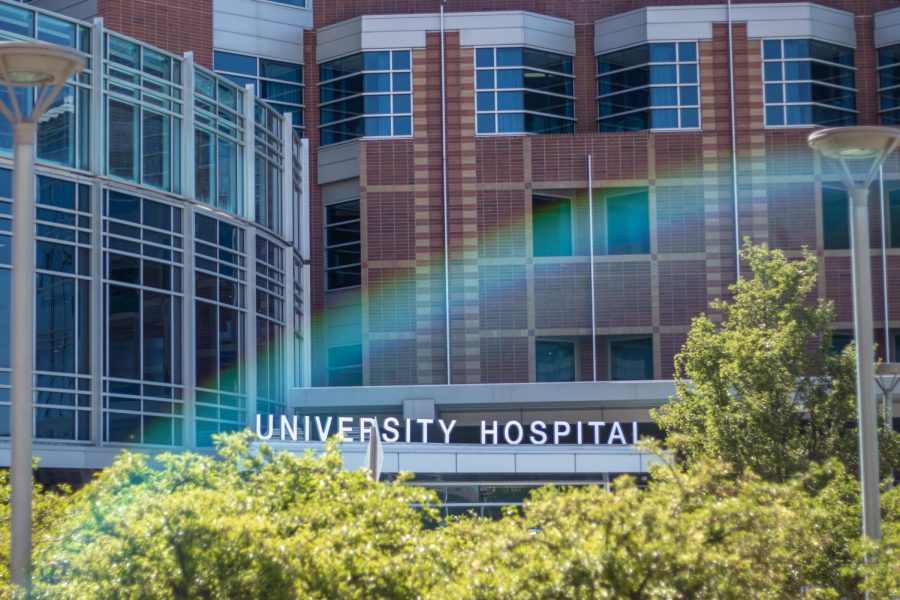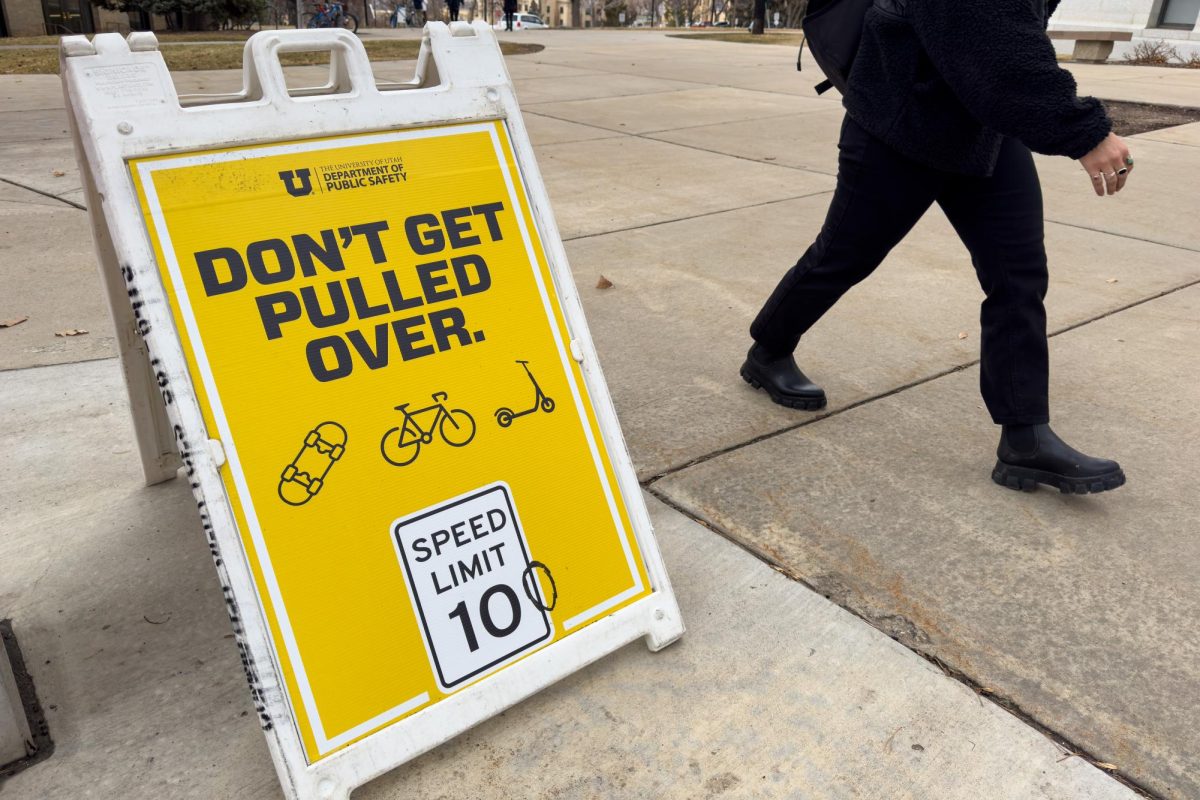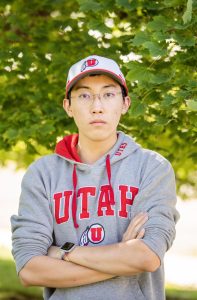The University of Utah’s new policy to ticket cyclists, scooter riders and skateboarders exceeding 10 miles per hour is unlikely to make our campus community safer. Instead, it distracts from the real problem: a lack of safe transportation infrastructure. Policing and penalizing students with additional fees might discourage active transportation, worsen our air quality and increase the campus’ carbon footprint.
It’s true that there have been collisions between pedestrians and rollers. These collisions happen because rollers have been pushed to the sidewalks given the lack of safe roller routes into and around campus. Rollers and pedestrians shouldn’t have to share infrastructure — it’s dangerous and will result in more collisions, especially as an increasing number of students live on campus.
The far more lethal collisions rollers are trying to avoid by riding on sidewalks are those with cars. One of the authors of this article was recently hit by a UTA bus while riding a bike on South Campus Drive. The campus designated South Campus Drive a bike route, effectively claiming it is safe for bikes. However, South Campus Drive lacks any bike lanes at all, let alone protected bike lanes. Rather, South Campus Drive has only the pernicious sharrows that are arguably worse than no bike infrastructure at all. When even a professional driver can’t see a cyclist, the problem is with the infrastructure rather than the drivers.
Rather than blaming the victims of the poor infrastructure, the U needs to rethink its transportation policy to encourage biking, walking and mass transit. To make active transportation safe and pleasant, we call on University of Utah leaders to make five changes.
- Separate pedestrian infrastructure from roller routes inside campus.
- Create protected roller lanes on roads across campus, particularly South Campus Drive from Guardsman Way to Mario Cappecchi Drive. Since some of these roads are state-owned, campus leaders need to work with the Utah Department of Transportation.
- Create and disseminate an interactive map showing where crashes between different mobility types occurred. This will help identify areas with the highest need for safety improvements.
- Price parking appropriately and invest the additional revenue into more frequent UTA bus service to the U. Parking at the U is more expensive than at other Utah state schools, but it is significantly cheaper and more convenient than at other flagship public research universities.
- Implement the same speed limit for cars as on rollers on campus-owned roads.
In a city among those with the worst air quality in the world on many winter days, the U has an opportunity to become a leader in accessible, sustainable transportation. We must do better to protect our students and community.
— Andra Ghent, Professor in the Department of Finance, Alessandro Rigolon, Associate Professor in the Department of City and Metropolitan Planning, and Katharine Walter, Assistant Professor in the Department of Internal Medicine
The Daily Utah Chronicle publishes guest op-eds written by faculty, elected officials and other members of the public on topics relevant to students at the University of Utah. The Chronicle welcomes guest op-ed pitches here.













SB • Feb 6, 2024 at 3:17 pm
I agree that roadway improvements would help, though the U doesn’t own any of the major east-west roads. This article missed an opportunity to call out UDOT – the owner of South Campus Drive & North Campus Drive – for not prioritizing improvements for our students and active commuters. These two roads create a barrier to campus for everyone outside of a car.
Andra Ghent • Feb 6, 2024 at 9:40 pm
Thanks SB. We agree 100% that UDOT is a big part of the problem, that’s why we need campus leaders (President Randall, the trustees), who have much more influence with the state legislature that controls UDOT, to help us get this issue fixed.
Alana • Feb 6, 2024 at 10:04 am
I’m a skateboarder at the U and I was hit by a bike riding the wrong way on the bike pathways. These pathways are INCREDIBLY small and one bike often takes up both lanes, obviously leading to disaster. The bike lanes are tiny and often full of students forcing us to ride on student pathways. The bike pathways at the U are incredibly dangerous as they stand. From extreme parking issues to unsafe bike paths, for being a commuter school the university makes commuting very difficult.
John Hedberg • Feb 6, 2024 at 3:44 am
Dear Articulate, well-meaning, but salaried (i.e. financially privileged) employees here at the U,
If you want an inclusive and accessible campus, speaking kindly, you’re barking up the wrong tree spending tens of millions in student/family funds on lane and sidewalk development. We can walk! The extra minutes of cardio in sunshine and fresh air will be healthy for both mood and vitality, especially the extra Vitamin D~!
Students are racking up ruinous debt from out-of-control education costs, so that none of us can look forward to forming a family and buying a home before we hit 35. The University charges 3 TIMES as much as Salt Lake Community College for the exact same classes (check their respective course catalogs and the rate/fee schedules: on top of ridiculous tuition rates, the U ‘offers’ zero-credit tuition rates before any credits are taken, 14 “mandatory fees”, plus supplemental fees like a “science differential”, e-text fees, program fees, and even a “success fee” which is somehow not included within tuition). BTW, both schools operate in the same county with the same cost of living, and SLCC fields multiple campuses. I can take 18 credits at SLCC at the same price I would pay for 4 credits here at the U.
Suggestions:
1. Immediately adopt the SLCC tuition/fee schedule here at the U, with maybe a 25% increase above SLCC prices to cover higher salaries for educators, which will still only be about half what U students pay now, and freeze these rates for the next five years. The State Legislature can provide any funding gaps that can’t be made up in other ways, since nothing is more important to Utah families than the education & professional success of the state’s future parents, leaders, and entrepreneurs.
2. Raise bonds and construct 3 new large-capacity parking structures, one just West (downhill) of Rice-Eccles Stadium, another just North of the Student Life Center & the HPER Complex (put the Impact & Prosperity Center on top of it?), and a final one just North of Merrill Engineering. This will provide students easy access to 3 strategically located landing-points that provide easy walking to most classes and recreational facilities. Charge a dollar a day to park, and put solar panels on the roof, so these can pay for themselves and provide upkeep.
3. Provide online options for most classes to commuters, which are much less expensive to the University, and yet will still provide easy access for the many off-campus students who work and have other responsibilities that make public transportation time consuming and impractical.
4. Don’t worry so much about Global Warming. A coalition of 1608+ world scientists, including Nobel physicists and even an Obama administration climate advisor, have published a signed declaration stating that while climate change is occurring, there is no actual emergency due to changing conditions: the changes are neither very fast nor very severe, and since CO2 is literally plant food, the world’s growing area has actually been expanding & getting greener (satellite data supports this).
It turns out that a lot of the climate models were based on faulty assumptions (hypotheses) that exaggerated the dynamics of change, and we’re actually near the lowest levels of CO2 ever registered in Earth’s planetary history: scientific study shows that plants are adapted to much higher CO2 than today’s, and vast new areas of presently subarctic permafrost are slowly warming, plants are growing faster in arid regions, and there is progressively more land area that supports green life in vast wilderness habitats like Northern Asia, Upper Canada, and Greenland.
So, in consideration of everyone’s health and well-being, and the planet’s, these 4 suggestions may be universally beneficial ideas we here at the U can enact to alleviate our existential worry over an issue that emerging data now shows could be a beneficial rather than a disaster: such temperature and CO2 fluctuations during the past few hundred million years created super-flourishing events of natural life, not the opposite, since faster-growing plants from all the extra CO2 provided abundant food for all kinds of fauna, a lot of it super-sized~! 😊 (shout out to the Natural History Museum).
Fred Samme • Feb 6, 2024 at 2:57 pm
These are perspectives and suggestions that I think could be applied to ASUU’s governing body effectively, as it concerns the voice of the students. With elections coming up and governing bodies actively writing legislation, I highly recommend suggesting it to your college’s representative; civic engagement is on the rise at the U, I encourage you to present these ideas to entities who can help develop plans and ideas to the university community in concrete ways!
Respectfully,
Fred Samme